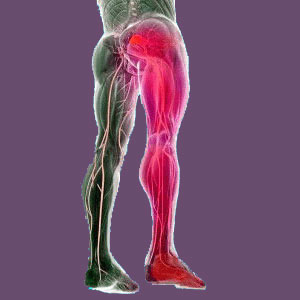
Are you suffering from a pinched sciatic nerve? Sciatica and pseudo-sciatica remain some of the most common and difficult to treat of all chronic pain syndromes. Worse yet, their symptomatic expressions can be functionally limiting and may even lead to disability in rare instances.
We have been writing on the subject of sciatica for more than 15 years and it remains one of our most researched topics. We have invested huge sums of time and money in proprietary research about the causes and cures for sciatica and have been publishing our findings for more than a decade. We hope that this essay covering piriformis compression of the sciatic nerve provides some insight as to yet another source of pseudo-sciatica symptomology.
This patient guide explores the definition of a pinched sciatic nerve. We will detail the possible sources of sciatic nerve impingement and also detail the actual clinical expectations of this type of compressive neuropathy syndrome versus the common mythologies of the condition.
Pinched Sciatic Nerve Causes
The sciatic nerve can be structurally compressed at various places in the lower body anatomy. When the nerve is compressed, or “pinched” as people like to call it, the nerve tissue will not function normally and can signal distress in the form of pain, tingling, numbness, burning or weakness affecting motor and sensory abilities in the buttocks, legs and/or feet.
The sciatic nerve does not meet the spine directly, although it is formed from the nerve roots that reside from L4 to S3. Therefore, no spinal structural issue can ever compress the sciatic nerve.
The most common cause of sciatic nerve impingement is piriformis syndrome. This occurs when the piriformis muscles spasms chronically and clamps down on the nerve, causing dysfunction and painful lower body symptomology.
The sciatic nerve can also be compressed by the tissues of the sacroiliac joint. This occurrence is less often observed, but does provide an alternative explanation when the piriformis muscle is not the culprit.
The entire sciatic nerve or branches of it can also be compressed locally in the anatomy of the leg. This can occur due to muscular causation, cyst formation or tumor formation, as well as injury and other less often observed causes.
Compressed Sciatic Nerve Symptoms
A truly compressed nerve is not generally the source of chronic pain. Instead, the nerve might be painful for a short time, but the symptoms will generally give way towards objective forms of numbness and weakness in the affected areas of the body. However, in piriformis syndrome, it is common for the sciatic nerve to suffer variable degrees and locations of compression, potentially causing chronic discomfort. Here are the usual symptoms of many pseudo-sciatica expressions associated with a compressed fully-formed sciatic nerve:
Widespread and variable pain, tingling, paresthesia and weakness in the legs and feet are the most common manifestations.
Burning or shooting pain are less common, but still reported in many patients, particularly in the major muscles of the legs.
Some patients might experience functional deficits, such as foot drop.
If the patient is also suffering a compressed pudendal nerve, then additional symptom will be present.
Pinched Sciatic Nerve Facts and Myths
Piriformis syndrome is a very real condition, but still suffers from some myths that might prevent accurate diagnostic processing or successful treatment:
One of the major problems with piriformis pain is that high incidence of symptoms being diagnosed as sciatica, implying a spinal origin. Since herniated discs, degenerated discs, spinal stenosis and osteoarthritis are basically normal and universally observed in adults in the lumbar spine, many sciatica symptom sets are blamed on these structural scapegoats. This leads to many failed treatments and often successful surgery on the spine. Piriformis syndrome is usually only considered as a diagnostic explanation after all of these other therapies fail. Patients must be aware that many spinal abnormities are scapegoated as causing pain unfairly and without evidence-based merit.
Remember too that many cases of piriformis syndrome are not created by injury or muscle imbalance as are the popular and incredibly incorrect working therapies of symptomatic causation embraced by many care providers. Instead, many chronic piriformis pain syndromes are actually motivated by oxygen deprivation and are detailed in our in-depth coverage of piriformis ischemia conditions.
Piriformis Pain > Piriformis Diagnosis > Pinched Sciatic Nerve





